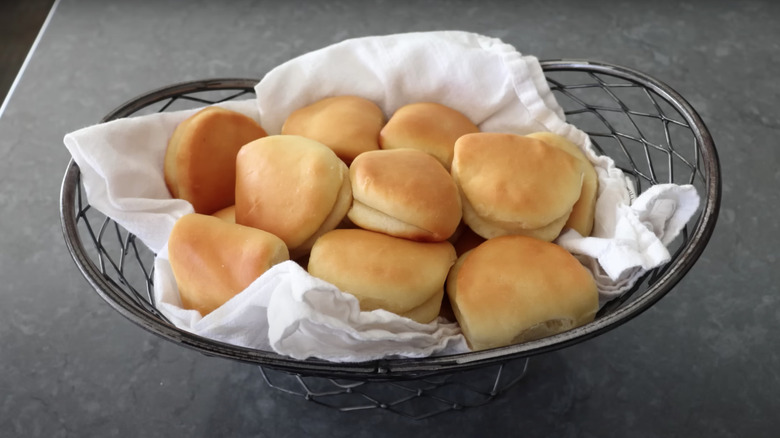The Possible Reason For Parker House Rolls' Unique Folded Shape
There are dinner rolls and then there are Parker House rolls and never the twain shall meet. Or at least, they shouldn't. While it's possible to see a dinner roll described as a Parker House roll on a menu, the latter has a distinct feature that sets it apart from the generic pack. The signature roll created at what is now Boston's Omni Parker House Hotel, which is also home to Boston Cream Pie, in the 1870s boasts a distinct folded shape that's "almost like a pocketbook," according to Omni Parker House historian Susan Wilson (via All Recipes).
Not to be confused with pocketbook rolls which are an entirely different shape, according to Cook's Info, authentic Parker House rolls are a soft and buttery yeast bread. The dough is painstakingly folded to create the signature crease that makes them so identifiable. Each roll starts as a 3-inch circle of dough rolled to be ¼-inch thick and coated with melted butter. Then, and this is the secret, the circle of dough is folded (butter side in) partially in half and the edge is pressed just enough to keep it in place through the rising and baking process. The exacting process ensures the finished product is a roll that's crisp on the outside and soft on the inside (via New England Today).
Okay, but why?
So, now we know what sets Parker House rolls apart from the pack and we know how bakers today create the rolls' signature crease, but why? And does the cleft have anything to do with the bread's long-held place in culinary history? Most importantly, is that quintessential crease the reason why 19th-century French composer Jacques Offenbach broke out in song, declaring, "Parker rolls, Parker rolls, how I love you!" upon tasting a Parker House roll (via Foodicles)? Or why, according to Historic Hotels of America, it took almost six decades and an official request from the White House, before the Parker House finally agreed to release the top-secret recipe, including instructions for recreating the rolls' unique folded shape. One would think the process emerged from an arduous recipe-development process, but legend says the shape was a happy accident.
According to Cook's Info, in the 1870s a German chef by the name of Ward was working in the Parker House kitchen under the direction of hotel chef John Bonello. Details vary by source, but the general consensus is an argument ensued in the kitchen. Some sources say a disgruntled employee threw a ball of dough at a wall, noticed its post-throw shape, and began recreating it. Others explain that an angry chef threw a batch of uncooked rolls into the oven, denting the dough and inspiring the signature shape. Whatever the truth, the fact is if it doesn't have the cleft, it's not a Parker House roll.

